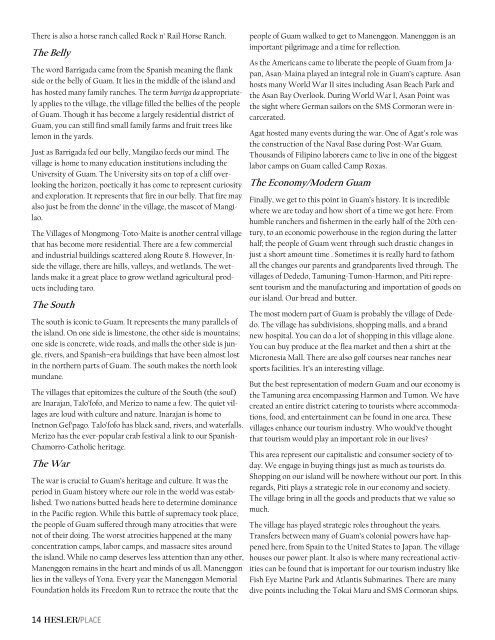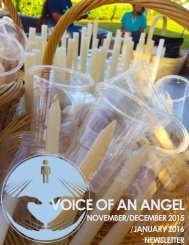Create successful ePaper yourself
Turn your PDF publications into a flip-book with our unique Google optimized e-Paper software.
There is also a horse ranch called Rock n’ Rail Horse Ranch.<br />
The Belly<br />
The word Barrigada came from the Spanish meaning the flank<br />
side or the belly of Guam. It lies in the middle of the island and<br />
has hosted many family ranches. The term barriga da appropriately<br />
applies to the village, the village filled the bellies of the people<br />
of Guam. Though it has become a largely residential district of<br />
Guam, you can still find small family farms and fruit trees like<br />
lemon in the yards.<br />
Just as Barrigada fed our belly, Mangilao feeds our mind. The<br />
village is home to many education institutions including the<br />
University of Guam. The University sits on top of a cliff overlooking<br />
the horizon, poetically it has come to represent curiosity<br />
and exploration. It represents that fire in our belly. That fire may<br />
also just be from the donne’ in the village, the mascot of Mangilao.<br />
The Villages of Mongmong-Toto-Maite is another central village<br />
that has become more residential. There are a few commercial<br />
and industrial buildings scattered along Route 8. However, Inside<br />
the village, there are hills, valleys, and wetlands. The wetlands<br />
make it a great place to grow wetland agricultural products<br />
including taro.<br />
The South<br />
The south is iconic to Guam. It represents the many parallels of<br />
the island. On one side is limestone, the other side is mountains;<br />
one side is concrete, wide roads, and malls the other side is jungle,<br />
rivers, and Spanish–era buildings that have been almost lost<br />
in the northern parts of Guam. The south makes the north look<br />
mundane.<br />
The villages that epitomizes the culture of the South (the souf)<br />
are Inarajan, Talo’fofo, and Merizo to name a few. The quiet villages<br />
are loud with culture and nature. Inarajan is home to<br />
Inetnon Gef’pago. Talo’fofo has black sand, rivers, and waterfalls.<br />
Merizo has the ever-popular crab festival a link to our Spanish-<br />
Chamorro-Catholic heritage.<br />
The War<br />
The war is crucial to Guam’s heritage and culture. It was the<br />
period in Guam history where our role in the world was established.<br />
Two nations butted heads here to determine dominance<br />
in the Pacific region. While this battle of supremacy took place,<br />
the people of Guam suffered through many atrocities that were<br />
not of their doing. The worst atrocities happened at the many<br />
concentration camps, labor camps, and massacre sites around<br />
the island. While no camp deserves less attention than any other,<br />
Manenggon remains in the heart and minds of us all. Manenggon<br />
lies in the valleys of Yona. Every year the Manenggon Memorial<br />
Foundation holds its Freedom Run to retrace the route that the<br />
people of Guam walked to get to Manenggon. Manenggon is an<br />
important pilgrimage and a time for reflection.<br />
As the Americans came to liberate the people of Guam from Japan,<br />
Asan-Maina played an integral role in Guam’s capture. Asan<br />
hosts many World War II sites including Asan Beach Park and<br />
the Asan Bay Overlook. During World War I, Asan Point was<br />
the sight where German sailors on the SMS Cormoran were incarcerated.<br />
Agat hosted many events during the war. One of Agat’s role was<br />
the construction of the Naval Base during Post-War Guam.<br />
Thousands of Filipino laborers came to live in one of the biggest<br />
labor camps on Guam called Camp Roxas.<br />
The Economy/Modern Guam<br />
Finally, we get to this point in Guam’s history. It is incredible<br />
where we are today and how short of a time we got here. From<br />
humble ranchers and fishermen in the early half of the 20th century,<br />
to an economic powerhouse in the region during the latter<br />
half; the people of Guam went through such drastic changes in<br />
just a short amount time . Sometimes it is really hard to fathom<br />
all the changes our parents and grandparents lived through. The<br />
villages of Dededo, Tamuning-Tumon-Harmon, and Piti represent<br />
tourism and the manufacturing and importation of goods on<br />
our island. Our bread and butter.<br />
The most modern part of Guam is probably the village of Dededo.<br />
The village has subdivisions, shopping malls, and a brand<br />
new hospital. You can do a lot of shopping in this village alone.<br />
You can buy produce at the flea market and then a shirt at the<br />
Micronesia Mall. There are also golf courses near ranches near<br />
sports facilities. It’s an interesting village.<br />
But the best representation of modern Guam and our economy is<br />
the Tamuning area encompassing Harmon and Tumon. We have<br />
created an entire district catering to tourists where accommodations,<br />
food, and entertainment can be found in one area. These<br />
villages enhance our tourism industry. Who would’ve thought<br />
that tourism would play an important role in our lives?<br />
This area represent our capitalistic and consumer society of today.<br />
We engage in buying things just as much as tourists do.<br />
Shopping on our island will be nowhere without our port. In this<br />
regards, Piti plays a strategic role in our economy and society.<br />
The village bring in all the goods and products that we value so<br />
much.<br />
The village has played strategic roles throughout the years.<br />
Transfers between many of Guam’s colonial powers have happened<br />
here, from Spain to the United States to Japan. The village<br />
houses our power plant. It also is where many recreational activities<br />
can be found that is important for our tourism industry like<br />
Fish Eye Marine Park and Atlantis Submarines. There are many<br />
dive points including the Tokai Maru and SMS Cormoran ships.<br />
14 <strong>HESLER</strong>/





